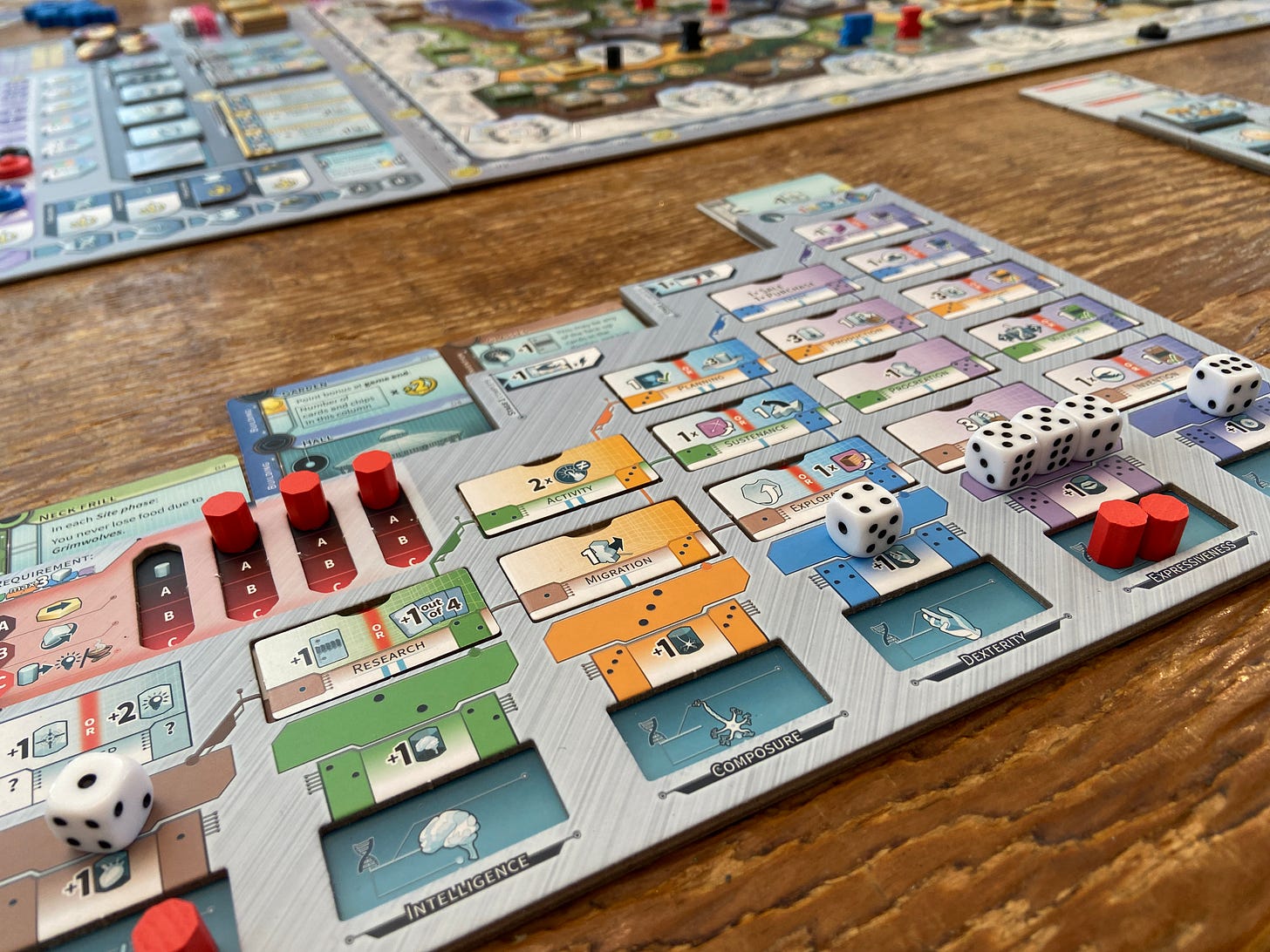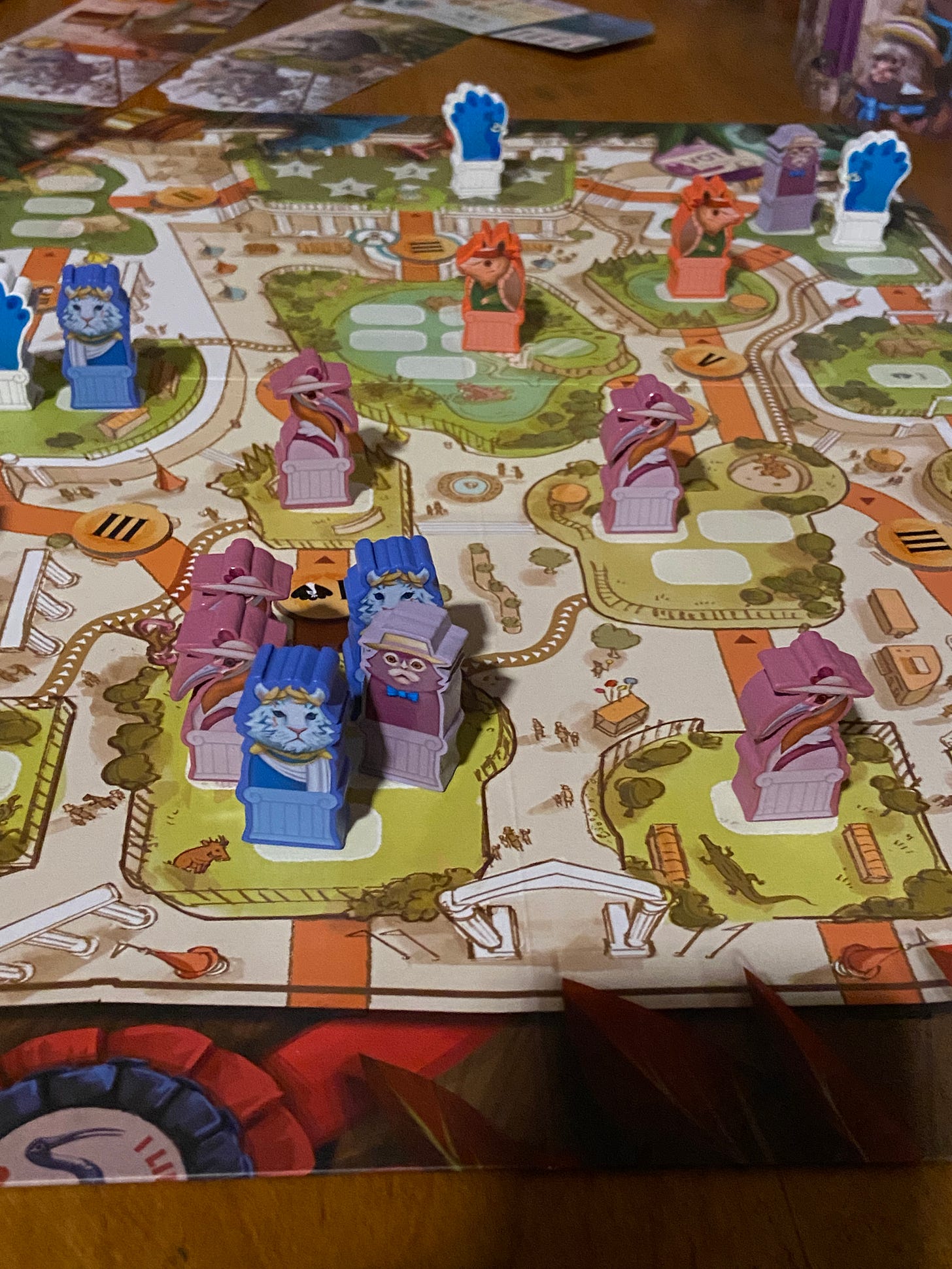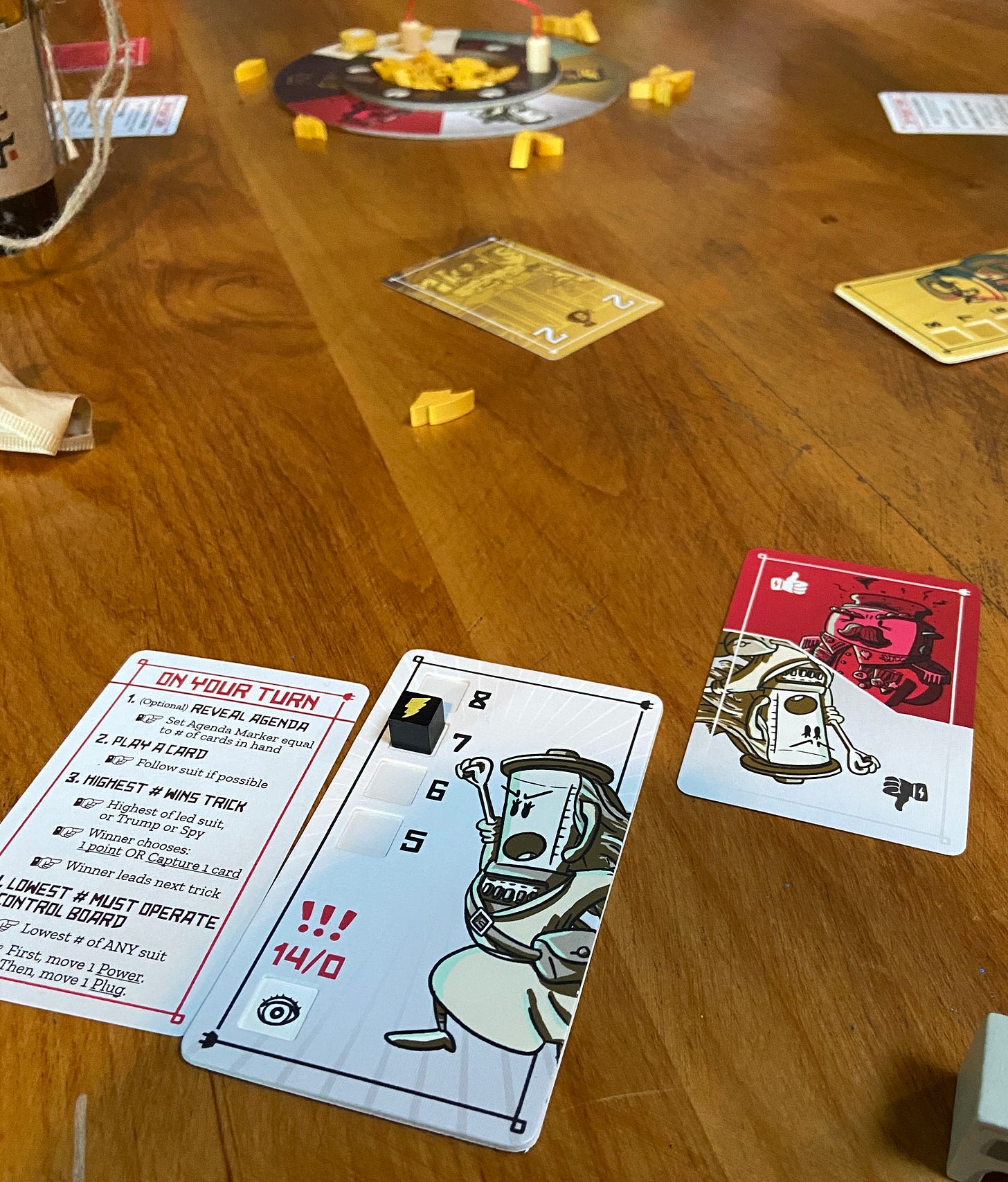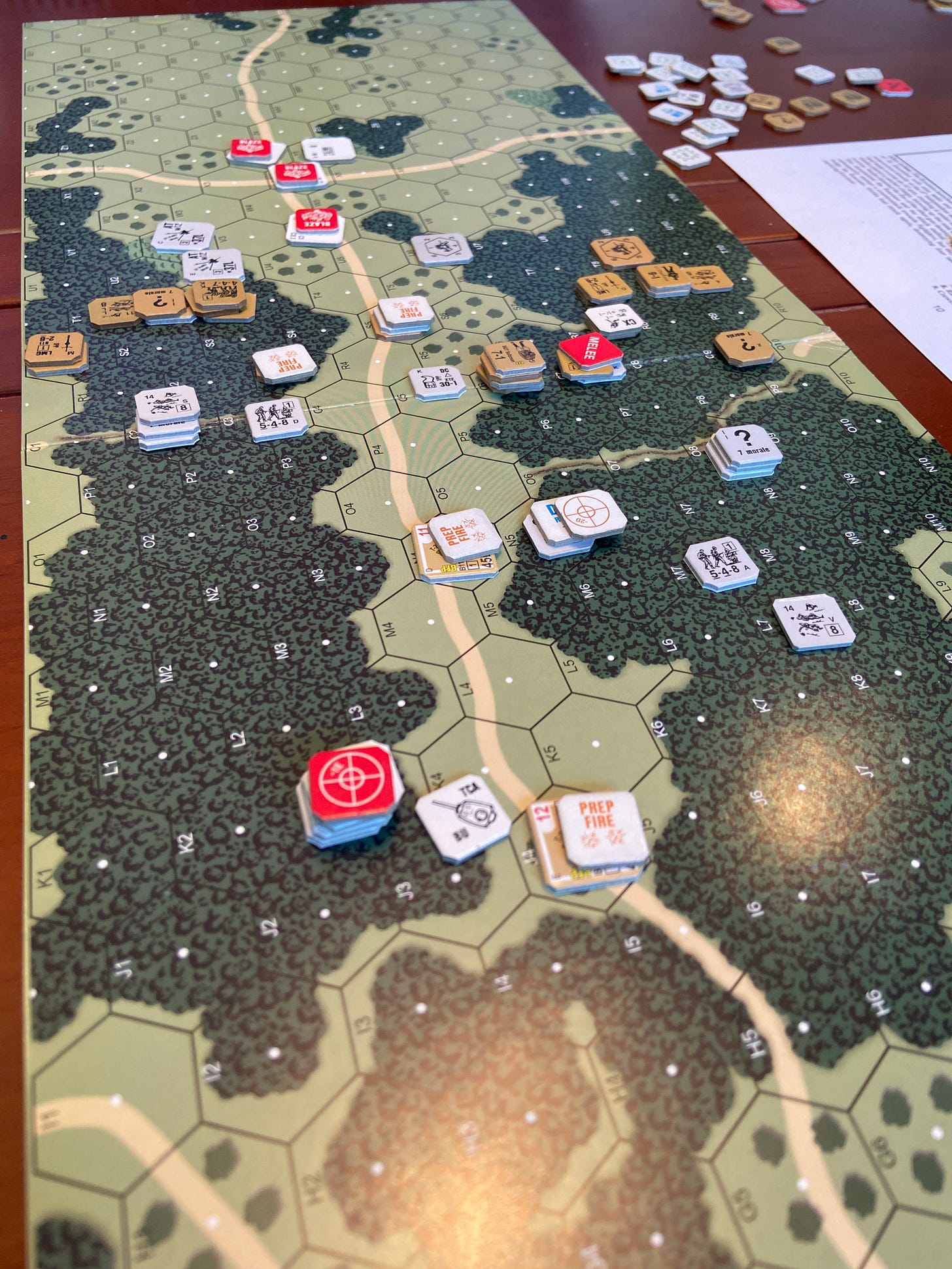Civolution, Zoo Vadis, Mannerheim Cross, Power Vacuum, and more
Week of March 31st, 2025
Stefan Feld has never been my favorite designer; I enjoyed a few of his earlier games (Notre Dame, Rum & Pirates, In the Year of the Dragon, Bora-Bora) but after playing an excruciating 3+ hour game of Castles of Burgundy and a tortured session of Trajan I was off the train and never really got back on. That said, I still think of him as a highly professional designer, just one who doesn’t make games to my taste.
Civolution has all the warning signs of a game I should hate: advancing on lots of tracks as a central mechanism. Detailed individual player boards. Complex procedures to get simple things done. Punishing randomness on top of that. Wild point salad scoring. Major risk of analysis paralysis and the associated punishing downtime. Plus only a very minimal sense of narrative and essentially no thematic content. That’s a lot of red flags.
Nevertheless, I enjoyed it more than I thought I would. Would I play it again? Probably not — it’s too long and the downtime is too problematic for me. I certainly wouldn’t play it with the full compliment of 4 players. Still, it has charms. It strikes me as Stefan Feld being given a blank check to go wild and make the game he’s always wanted to make. It’s a very stereotypical Feld game, dialed up to 11. Actions are driven by dice as in Castles of Burgundy, but you use two dice at a time and every two die combination activates a different unique action, from adding population to migrating to developing technology to trading goods to manipulating dice to mutating your species. These may develop advancements in 5 different categories, produce one of 18 different types of goods, and evolve 6 different kinds of adaptations. It’s all kind of nuts. Doing anything significant involves many steps. There is very little leverage in the system.
The thing that I find interesting is that on top of this, the game is super-chaotic. Your access to the various development cards is limited, so getting one that you can easily use either because it requires one of the couple of resource out of 18 that you have easy access to, or because it has a strong game-long power and you can get it down early, is huge. If you can grab one of the three special powers on the market because you happen to have the right combination of the 6 adaptations that’s a big deal.
So if this is all true, why did I find it pleasant enough? Well, it’s undeniably slick. For a game of its considerable complexity it’s structurally quite clean and while it’ll take even a good rules explainer half an hour to teach it well enough to get going, that’s not actually crazy compared to games in its weight class. It’s an interesting mix of constraints. The 6 dice you roll each cycle (a game is only 3 eras and each era involves maybe 4 cycles) constrain you a lot, so you’re actually fairly limited in how you can engage with the massive game space, and dealing with those constraints — whether it’s working within them or spending effort to expand them through dice modifiers or extra dice — provides interesting tension. There is some satisfaction to be had in finding a way through this maze to string together the actions required to get one card into play.
At the end of the day though, this is still very Feldian in that it’s a complex, opaque, athematic point salad with limited player interaction. For me, it’s very hard to engage with a game where the scoring is so incredibly complex, doing simple things is intricate, there is no sense of narrative or setting, and you only occasionally need to be cognizant of what other players are doing. As well-executed as a game like this may be, the process of solving it doesn’t engage me. I know this style has been in the vogue in hobbyist gaming for a while now, which often leaves me feeling a bit disconnected from the hobby at large. But there it is.
Quo/Zoo Vadis is a game that in theory I love, and has outlived any of the similar negotiation games in my collection (Bohnanza, Traders of Genoa, Chinatown, and Intrigue, just to pick a few). I like deal-making games! But they aren’t super-popular with the people I normally play with, so it was fun for me to get in a couple games at the Guildhouse Meetup group.
Fortunately or unfortunately, the younger folks there do like games like this, so I found myself outclassed, flailing around trying to get things done and largely failing. This resulted in my feeling a bit frustrated, and wondering if I really liked or understood the game. I thought about it a lot on the drive home.
My history with trading and negotiation games is primarily games like Civilization, Bohnanza, Chinatown, Roll Through the Ages, Catan, and such where trading creates so much value and so is beneficial to both parties that you’re almost always better off making a deal, almost any deal, as long as it’s not obviously stupid. The other player may do better than you on this particular deal, but in the long run if you’re active in making deals and make a lot of trades — within reason — you’ll come out ahead of players who hesitate.
Zoo Vadis is not one of these games. Deals do create value, sometimes significant value, but the number of deals available to make is limited — you can only provide value in a spot where you have at least some presence, and you’re only going to make one move per turn and maybe half-a-dozen over the course of the game (one of the charms of Zoo Vadis is that it’s quite short). So you can’t make it up in volume, there are just not that many deals available to be made, and you have to squeeze value out of each.
In many ways it reminds me of Modern Art. Each deal opportunity will create value in terms of points and in terms of position (advancement). You both need to advance to the top, and also have the most points, so you need to balance these things against each other. Points aren’t super-hard to evaluate, but advancement is opaque. Like Modern Art, there is enough information to make a disciplined evaluation, but there are also going to be huge error bars much of the time. That’s what’s going to make or break you: evaluating how much an advancement is worth, and so how much to try to extract in concessions when you agree to elevate another player. Also like Modern Art, things like your fellow-players’ tolerance for risk and aggressiveness in making deals will be a huge factor in how you approach the game.
So yes, I do really like this game. I hope I can get it in a little more often now that I’ve found some players who like it.
This is a game called Power Vacuum, from Keen Bean Studio. It’s another trick-taking game, but it’s just absolutely gonzo, packed full of ideas, some of which maybe should have been left out. Let’s start with the theme: we’re all anthropomorphic home appliances, and the vacuum cleaner has just died so we all have to wrestle for household supremacy.
It’s a crazy variant of Wizard/Oh Hell, where you can get points for taking tricks but the real points are in your prediction of who is going to win a hand and who is going to lose it the hardest. These prediction points vastly outweigh points for tricks, moreso even than in Wizard. The other variations from a normal trick-taker are as follows: red is always trump; the cards are two-sided with just the suit on the back so people can see what suits you have; there is a brown suit which is super-trump and has one of the 4 regular colors on the back, but super-trump only wins if trump is played; and you have to follow suit but you can always play trump or super-trump, even if you have the lead suit; and there are modest rewards for winning the trick but the player who played the lowest card gains a significant ability to shift points between players which is actually more powerful.
It’s all just a bit nuts. The ability to always drop trump makes it feel totally chaotic, and it’s really about timing your low cards to gain control (although taking tricks is still good). The trumps and super-trumps are extremely confusing to explain. The card backs sound like a clever idea but in practice are often hard to see depending on how people hold their cards. Since players can always drop trump and super-trumps are hidden, it also doesn’t feel super-relevant. Perhaps the most problematic thing though is that for a slight and very wacky trick-taker, it’s long, over an hour. If you’re not one of the gamers who enjoys endless variations on trick-taking games, it’s hard to recommend. I like these games more than many hobbyists, but I was very ready to be done well before the last round.
It did remind me I should throw Mü & More into my travel bag of games.
Bounding Fire Productions recently released their latest large ASL module/scenario pack, Mannerheim Cross, which covers the Finnish involvement in WWII from the Winter War through to the Continuation War and the Lapland War. The way the Finns have been handled has had a troubled history in Squad Leader starting with Crescendo of Doom through the early days of ASL, being portrayed as super-soldiers in a way that didn’t feel great (the old Avalon Hill had some problems which should be evident from looking at the old Squad Leader and Up Front box covers). The Hakkaa Päälle module for ASL finally changed all this in 2015 by giving us a rebuild of the Finns that, while still heightening contrasts in the name of evoking history rather than trying to simulate it, was more grounded. Instead of the Finns being essentially all elite, we now have line and reservist troops and a more balanced portrayal. The Finns are now super-fun to play, with a very distinctive feel of trying to exploit their resilience and adaptability to terrain and weather in the face of usually being badly outnumbered. It just became frustrating that we didn’t have that many scenarios.
(As a brief aside, our understanding of history today is in a so much better place than it was when I first got into historical gaming 40-something years ago. The Winter War was an obscure topic back then which I was very frustrated trying to learn more about in mainstream English-language sources. Today a non-professional-historian has so much better access to much higher-quality information. Here is a YouTube video on the Winter War from my favorite YouTube military history channel, Realtime History).
So, Bounding Fire to the rescue with one of their patented enormous scenario packs. It seems that everyone has to do new rules and counters these days, for better or for worse, so we get a bunch here. Some of the new stuff is sensible — heavy fortification rules for the Mannerheim Line, some fleshing out of Finnish anti-tank techniques including AT-heroes and boulders. I even like all the crazy aircraft counters, which are flavorful and involve basically no new rules, and of course BFP makes terrific mapboards. Some of what’s included is a lot more questionable though. We get 4 whole new squad types for Soviet Naval Infantry, which is absurd — the only meaningful historical differences between a Red Army squad and the Naval Infantry squad were: a) maybe one or two extra SVT-40 semi-automatic rifles replacing Mosin-Nagants, and b) the uniforms. There was absolutely no reason to create new squad types for them, the existing ones were fine. Likewise it uses the highly suspect 2nd line Soviet units from Poland in Flames (although their use has been heavily curtailed, and so the counters are not included and you’ll need Poland in Flames for a couple scenarios) and random new leaders with low morale but high leadership ratings. It’s all fine, but it’s also wildly unnecessary and arguably makes the game very slightly worse. Who looks at ASL and thinks hey, you know what this game really needs? More rules and more squad types!
We played scenario BFP-158, Mutka Strikes Again, which is a Chas Smith design — he’s designed the bulk of the 44 scenarios. To my mind Chas, Pete Shelling, and Mark Pitcavage by the far the most interesting and reliable ASL scenario designers, so it’s always great to get a bunch of new ones from one of them. It again highlights the uniqueness of the Winter War, with some heavily outnumbered Finns ambushing an exposed Soviet column and then trying to fight a delaying action through dense woods in the snow. Delaying actions are always treacherous for the defender, and while I thought I had gotten pretty good at it in other contexts the Finns are a different challenge and I just ended up getting swamped as the Soviets maneuvered around the flanks and found gaps. I really liked the scenario though.
Quick Takes
In the Shadows: My opponent who owns this and I had a 30 minute opening so we gave it another try. It worked much better and we had a reasonably competitive game with a Resistance victory. Neither of us really changed anything in our strategies or tactics from our previous total blowouts, so I just think it’s a really fragile game. Like a lot of these games, it pays to draw a lot of ops out of the deck. I’m reminded of Flashpoint: South China Sea, where essentially the only strategy was to draw more ops than your opponent. So anyway, I would no longer say it’s totally unbalanced, just uninteresting.
Edge of Darkness: it’s always fun for me to get a game of this in, and we tried two new-to-me bits of expansion content. First, the asymmetrical Guild House powers, which were simple and fine but inessential. Secondly, the cards and buildings from the Emissaries of the Vale expansion, which were fun. I like the different flavors of the different expansions; Emissaries of the Vale gives you powerful and flexible Growth tokens which are a currency you can earn and spend in multiple ways (depending on which buildings are in use) and add a new level of power and flexibility. I know I always say this about the game, but I love the vast range all the different building give it, and as a shared-deck-builder it has a fluidity that traditional build-your-own-deck deck builders don’t.
El Dorado has had a somewhat random spike in play recently — and not just that, but going back to the classic game with no expansions. We’ve been playing the fan maps from The Secret Paths to El Dorado (which you can find on BGG) and this has been really fun. Most of my vast numbers of plays of this game have been on the maps that are included in the game and its expansions, so seeing some new ones is both engaging and also a reminder of the crazy breadth of the game and how well the map tiles are designed. I still do generally avoid the oddball ones where there are split paths or large clusters, and if you stick the the more traditional layouts it’s really hard — not impossible, but really hard — to do something that’s not interesting.
I was also able to revisit Sekigahara for the first time in quite a while. BGG says I’m up to 25 plays and it still finds ways to play out a bit differently each time and still be exciting and engaging.
Coda
The US Air Force Band was in town this week. The various major US service bands (Marine, Army, Navy, Air Force, Coast Guard) really are national treasures, composed of top musicians and on par with top world orchestras. If you ever have a chance to hear them, you should go.
That’s all! See you next week!







Thanks for your thoughts on Civolution. We are up to 17 plays and get through two player games in 70 minutes and our first four player game was 130 minutes. That’s okay for us. I shouldn’t like it as a long time Knizian but I actually adore it. I don’t quite know why. Also, a game is four eras, but I think you mentioned three … is there a shorter version?
Mu is likely my favorite trick taking game. The old Tandem crowd (Jeff, Chris, etc) now play regularly via BGa (it’s in a pretty big free beta mode now) to get our fix in.